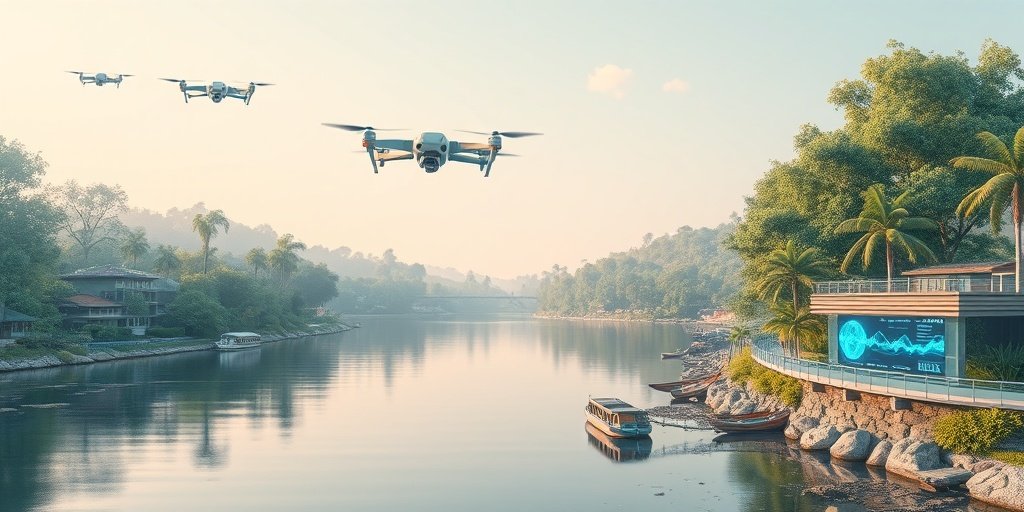⚡ Quick Summary
This comprehensive review explores the use of Artificial Intelligence (AI) in detecting and controlling river water pollution, analyzing over 110 research articles from 2019 to 2024. The findings highlight significant advancements in Machine Learning (ML) and Deep Learning (DL)
🔍 Key Details
- 📊 Dataset: Analysis of over 110 research articles
- 🧩 Technologies used: Artificial Neural Networks (ANN), Deep Neural Networks (DNN), Long Short-Term Memory (LSTM), Random Forest (RF)
- 🌐 Integration: Internet of Things (IoT) for real-time monitoring
- 📅 Timeframe: Studies from 2019 to 2024
🔑 Key Takeaways
- 💧 River water quality (WQ) is crucial for assessing the health of aquatic ecosystems.
- 🤖 AI technologies are being increasingly applied to tackle river water pollution.
- 📈 Key advancements in ML and DL have shown promising results in water quality simulation.
- 🌍 IoT integration enhances real-time monitoring and predictive capabilities.
- 🔍 Challenges in managing nonlinear, nonstationary datasets remain significant.
- 🔮 Future research opportunities are abundant in the field of sustainable water resource management.
- 🌱 Protecting aquatic ecosystems is essential for maintaining biodiversity and environmental health.

📚 Background
Water quality is a vital indicator of the health and safety of water bodies, particularly rivers, which are often subjected to pollution due to anthropogenic activities in their basins. The increasing contamination of rivers poses a significant challenge to environmental sustainability and public health. As such, innovative solutions are necessary to monitor and manage water quality effectively.
🗒️ Study
This review provides a detailed overview of AI-based techniques and algorithms that have been developed to address river water pollution. By analyzing a substantial body of literature, the authors aim to highlight the practical applications of these technologies in real-world scenarios, focusing on their effectiveness in simulating and controlling water quality.
📈 Results
The review identifies several key advancements in AI technologies, particularly in ML and DL. Models such as Artificial Neural Networks (ANN), Deep Neural Networks (DNN), Long Short-Term Memory (LSTM), and Random Forest (RF) have shown significant promise in accurately simulating river water quality. Furthermore, the integration of IoT technologies has proven beneficial for enhancing real-time monitoring and predictive capabilities through continuous data collection.
🌍 Impact and Implications
The findings of this review underscore the potential of leveraging advanced technologies to develop sustainable solutions for water resource management. By utilizing AI and IoT, we can improve the monitoring and control of river water pollution, ultimately protecting vital aquatic ecosystems and ensuring the health of our water bodies. This research paves the way for future innovations in environmental management.
🔮 Conclusion
This comprehensive review highlights the transformative potential of AI in addressing river water pollution. By harnessing the power of ML, DL, and IoT, we can create more effective strategies for monitoring and managing water quality. The future of sustainable water resource management looks promising, and continued research in this area is essential for protecting our precious aquatic ecosystems.
💬 Your comments
What are your thoughts on the role of AI in combating river water pollution? We would love to hear your insights! 💬 Leave your comments below or connect with us on social media:
Artificial intelligence based detection and control strategies for river water pollution: A comprehensive review.
Abstract
Water quality (WQ) is a metric for assessing the overall health and safety of water bodies like a river. Owing to the habitation of anthropogenic habitation around its basin, the rivers can become one of the most contaminated water sources globally. The solutions to prevent and remit the impact of river water pollution faces many challenges, one of these entails the management of nonlinear, nonstationary water related dataset. This paper provides a detailed overview of Artificial Intelligence (AI) based techniques and algorithms, highlighting their practical applications in the critical domain of river water pollution diction and control. This review shows models for river WQ simulation from 2019 to 2024, in which over 110 research articles from various databases are analyzed. Key advancements in Machine Learning (ML) and Deep Learning (DL) technologies, including Artificial Neural Networks (ANN), Deep Neural Networks (DNN), Long Short-Term Memory (LSTM), and Random Forest (RF), are highlighted. Besides that, the amalgamation of Internet of Things (IoT) technologies is tested, showing their role in enhancing real-time monitoring and predictive capabilities through continuous data collection and advanced ML/DL models. This review addresses critical challenges and identifies emerging opportunities for future research by showcasing the application of ML, DL, and IoT innovations in surface WQ modeling. It highlights the potential of leveraging advanced technologies to form strengthen solutions for sustainable water resource management and the protection of vital aquatic ecosystems.
Author: [‘Bhatt D’, ‘Swain M’, ‘Yadav D’]
Journal: J Contam Hydrol
Citation: Bhatt D, et al. Artificial intelligence based detection and control strategies for river water pollution: A comprehensive review. Artificial intelligence based detection and control strategies for river water pollution: A comprehensive review. 2025; 271:104541. doi: 10.1016/j.jconhyd.2025.104541